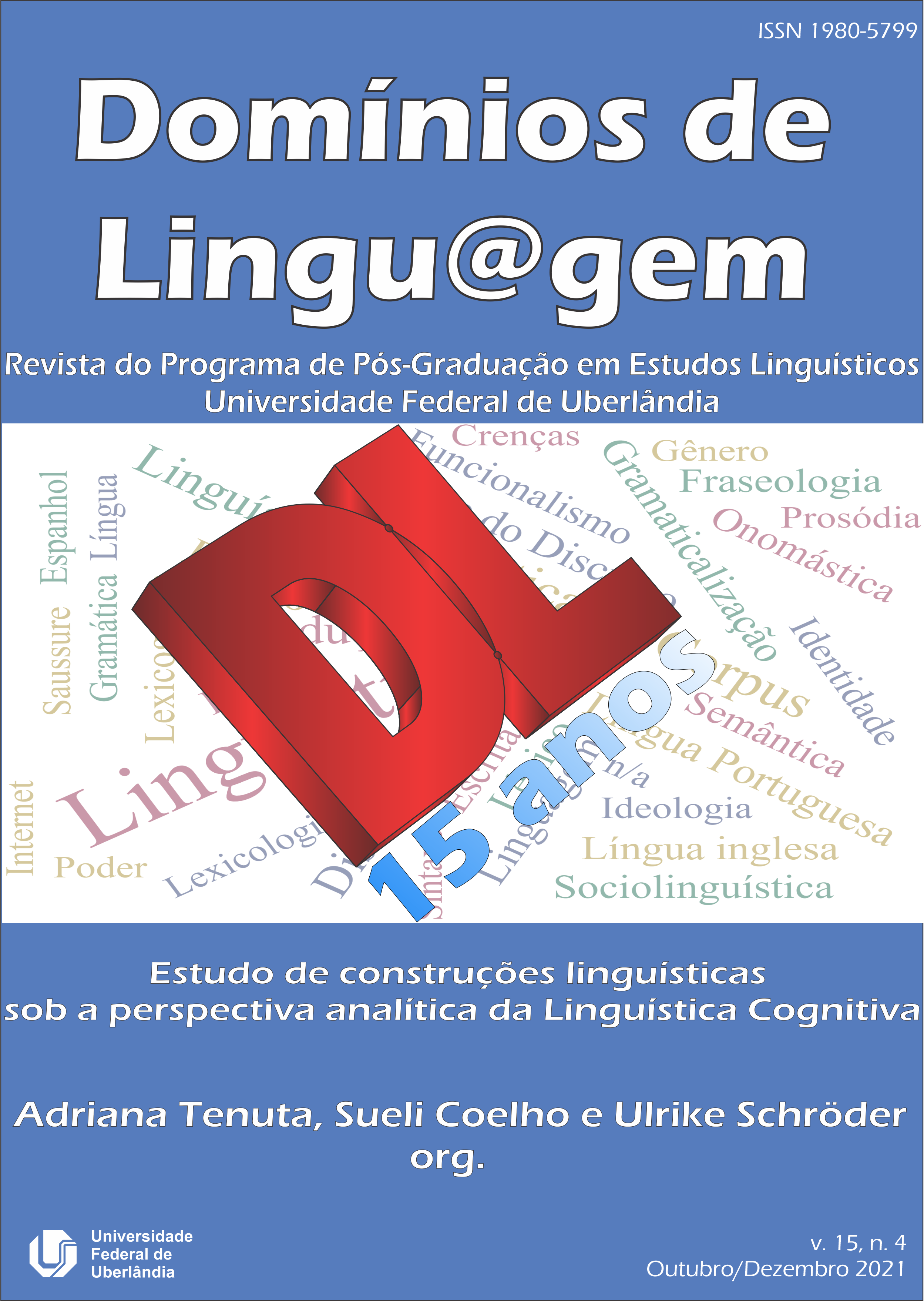Construção Concessivo-Comparativa “Até que para um palhaço, você escreve legal” como um elogio estranho
DOI:
https://doi.org/10.14393/DL48-v15n4a2021-10Palavras-chave:
Gramática das Construções. Espaço Mental. Mesclagem.Resumo
Neste trabalho, discutimos acionamento de pressuposição e mesclagem conceptual, a partir de contribuições da Teoria dos Espaços Mentais (FAUCONNIER,1994, 1997; FAUCONNIER; TURNER, 2002), na estrutura que chamamos de Construção Concessivo-Comparativa, esquematizada como “ATÉ QUE PARA X, Y” e instanciada em ocorrências como “Até que pra um avô você ainda está em forma, hein”. Seguindo o aporte sociocognitivista da Gramática das Construções (GOLDBERG, 1995, 2006; FILLMORE, LEE-GOLDMAN & RHOMIEUX, 2012), a partir de abordagem teórico-metodológica baseada no uso, com um banco de dados formado por ocorrências autênticas retiradas da internet, objetivamos legitimar a Construção Concessivo-Comparativa como um recurso avaliativo da língua que pode promover uma crítica velada. Após análise empírica dos dados, destacamos que esta construção parece promover um processo de mesclagem conceptual, que relaciona escalas entre os espaços mentais e promove o surgimento de categoria ad hoc, em que a avaliação feita é relativizada a um grupo de expectativas.
Downloads
Referências
COULSON, S. Semantic Leaps: Frame-shifting and conceptual blending in meaning construction. Cambridge: Cambridge University Press, 2001. DOI https://doi.org/10.1017/CBO9780511551352
CROFT, W.; CRUSE, D. A. Cognitive Linguistics. Cambridge: Cambridge University Press, 2004. DOI https://doi.org/10.1017/CBO9780511803864
DIEMER, S. Corpus Linguistics with Google?. In: Proceedings of the 2nd Conference of the International Society for the Linguistics of English. International Society for the Linguistics of English. Boston, 2011. Disponível em: http://www.bu.edu/isle/files/2012/01/Stefan-Diemer-Corpus-Linguistics-with-Google.pdf. Acesso em: 13 jan. 2016.
FAUCONNIER, G. Pragmatic entailment and questions. In: SEARLE, J.; KIEFER, F.; BIERWISCH, M. (org.). Speech act theory and pragmatics. London: D. Reidel Publishing Company, 1980. DOI https://doi.org/10.1007/978-94-009-8964-1_3
FAUCONNIER, G. Mental spaces: Aspects of meaning construction in natural language. Cambridge: Cambridge University Press, 1994. DOI https://doi.org/10.1017/CBO9780511624582
FAUCONNIER, G. Mappings in thought and language. Cambridge: Cambridge University Press, 1997. DOI https://doi.org/10.1017/CBO9781139174220
FAUCONNIER, G.; TURNER, M. The way we think: Conceptual blending and the mind’s hidden complexities. New York: Basic Books, 2002.
FILLMORE, C. J. Frame semantics. In: Linguistics in the morning calm. Selected papers from SICOL-1981. Seoul, Korea: Hanshin Publishing Company, 1982.
FILLMORE, C.; KAY, P.; O’CONNOR, M. C. Regularity and idiomaticity in grammatical constructions: the case of let alone. Language, Vol 64, No 3, p. 501-538, 1988. DOI https://doi.org/10.2307/414531
FILLMORE, C.; LEE-GOLDMAN, R.; RHOMIEUX, R. The FrameNet Constructicon. In: BOAS, H.; SAG, I. (org.). Sign-based construction grammar. Stanford: CSLI Publications, 2012.
GOLDBERG, A. Construction: A construction grammar approach to argument structure. The University of Chicago Press, 1995.
GOLDBERG, A. Constructions at work: the nature of generalization in language. Oxford: The Oxford University Press, 2006.
PINHEIRO, D. Um modelo gramatical para a linguística funcional-cognitiva: da Gramática de Construções para a Gramática de Construções Baseada no Uso. In: ALVARO, P. T.; FERRARI, L. (org.). Linguística Cognitiva: da linguagem aos bastidores da mente. Campos dos Goytacazes, RJ: Brasil Multicultural, 2016.
SALOMÃO, M. M. M. Gramática das Construções: a questão da integração entre sintaxe e léxico. Veredas- revista de estudos linguísticos. v. 6, n. 1. jan/jun.2002. Juiz de Fora: Editora UFJF, 2003. Disponível em: https://www.ufjf.br/revistaveredas/files/2009/12/cap042.pdf . Acesso em: 31 dez. 2020.
SALOMÃO, M. M. M. Tudo certo como dois e dois são cinco: todas as construções de uma língua. In: MIRANDA, N. S.; SALOMÃO, M. M. M. (org.). Construções do português do Brasil: da gramática ao discurso. Belo Horizonte: Editora UFMG, 2009.
SWEETSER, E.; FAUCONNIER, G. Cognitive links and domains: basic aspects of mental space theory. In: FAUCONNIER, G.; SWEETSER, E. (org.). Spaces, worlds, and grammars. Chicago University Press: Chicago, 1996.
Publicado
Edição
Seção
Licença
Copyright (c) 2021 Gabriela da Silva Pires, Luiz Fernando Matos Rocha

Este trabalho está licenciado sob uma licença Creative Commons Attribution-NonCommercial-NoDerivatives 4.0 International License.
Autores que publicam nesta revista concordam com os seguintes termos da licença Creative Commons
CC BY-NC-ND 4.0: o artigo pode ser copiado e redistribuído em qualquer suporte ou formato; os créditos devem ser dados ao autor original e mudanças no texto devem ser indicadas; o artigo não pode ser usado para fins comerciais; caso o artigo seja remixado, transformado ou algo novo for criado a partir dele, o mesmo não pode ser distribuído.
Autores têm autorização para assumir contratos adicionais separadamente, para distribuição não-exclusiva da versão do trabalho publicada nesta revista (ex.: publicar em repositório institucional ou como capítulo de livro), com reconhecimento de autoria e publicação inicial nesta revista.









